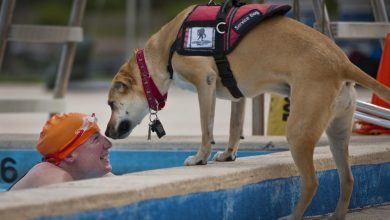Pets & Animals
How do you train a service dog?
Dog fans know the advantages of a pet companion are too many to mention. In addition to this, some dogs offer professional service to individuals who want it. Due to the ADA’s judgment in 1990, these service dogs are more than just pets. Which dogs are most appropriate to be service dogs, and how can they get certified?
The brief answer: any breed! Having said that, German shepherds, golden retrievers, Labrador retrievers, and border collies are typical for many different services due to trainability and typical personality. A larger dog might be necessary for physical help like freedom, but medical alert services or psychological support can be carried out by a smaller breed.
Not sure of your dog’s breed cosmetics? The Wisdom Panel evaluation is a reasonable alternative that receives high marks for accuracy.
Overall, your dog’s temperament and health are important.
You may also want to check out our guide to boosting therapy dogs, which can be associated with, but different from, service dogs.
Step 1: Health
A visit to the vet (with routine checkups) is important: health ailments like diabetes and arthritis place an undue strain on the top of pets, thus adding service animal responsibilities is unwise.All service dogs must also be neutered so that men are less aggressive and females do not confront working when in heat. Dogs should be at least 6 weeks old and beyond the puppy phase, also.
Step 2: Test dogs personality
Many dogs are aggressive while others are submissive, and in many instances this is not”good” or”bad”– it is not that easy. The ideal character for a service animal is a really narrow margin between these two poles. If your dog is calm, cool, and collected, but also attentive and responsive, chances are she is a fantastic fit for service work. Paw Rescue has a excellent primer on dog character, with additional resources for analyzing ideas.
As mentioned above, it can be very helpful to learn about your dog’s typical breed characteristics. For those who get a mixed-breed pooch, a respectable doggy DNA test can help you understand their heritage better.
Step 3: Find a Respectable Service Dog Trainer
Certain individuals have a DIY spirit, but a lot people will not be up to the job of the in-depth training needed to have a tested assistance animal. Legally in the USA, there’s absolutely no necessary certificate, but the service animal training community has produced self-regulated, minimum standards for training. Search for a respectable trainer near you!
Step 4: Time to Train Your Own Service Dog
Placing in the needed quantity of time is crucial. That is why it’s advisable to use an established coach.
International standards are a minimum of 120 hours over six months or more–up to 24 in certain instances. At least 30 of those hours ought to be time spent in people dealing with all the distractions and possible surprises that come with it.
While the U.S. has no defined necessity, self-regulation is critical and these hours and guidelines are wise to follow. They break down into the following three stages:
- Heeling can be tricky to teach dogs. It’s far more nuanced than”come here” or”sit,” It is about keeping relative position to the handler (human spouse ) no matter how the handler moves.
- Proofing can be time consuming, as it requires training the dog to tune out all distractions and always be on control.
- Tasking, or studying the particular task they will be doing, is what most people today think will be most difficult. After surmounting the other two theories, this is often the easiest. Tasks include providing guidance or feeling a health alert.
Step 5: Public Access test
It is time for prime time. Video documentation is always useful when it is time to put all that training to the test.
- No aggressive behavior (biting, barking, growling, etc.. )
- Only urinating or defecating on control
- Surcease of Allergic behaviours
- No solicitations for affection or food
The ADI provides a public access test in PDF form you can download and use.
Step 6: Registration and equiping
Again, our current situation in america is self-regulated. That means we will need to be polite in our public behavior as the dogs we have so diligently trained.
Documenting the training procedure, public access test, and registering with a respectable service like the United States Service Dog Registry can help ensure canine proficiency and any future scenario where your dog (or you) may be contested.
The ADA has set in great defenses to protect individuals in need of service animals and their pet spouses, but having strong answers and evidence in the event of misunderstanding or altercation is not likely to hurt. If our dogs can go the additional mile, then so can we.
Step 7: Finding someone in need
Only having a trained service animal does not mean that they can accompany you, or just anybody, into regions pets are refused. Public accommodations must lawfully be made for service dogs that are accompanied by the person with the disability.
To place a service dog, or to find one, check with local service dog organizations and community groups, such as Nextdoor (which also includes a great new Pet Directory.)
Service dogs offer help for individuals facing one or more potentially disabling life conditions. Together with physical disabilities, this includes depression, anxiety, and PTSD. In the event you or someone you care about may benefit from a service dog, these steps can allow you to check if your pet spouse has the capacity to be of even greater service than the unconditional love they provide.



